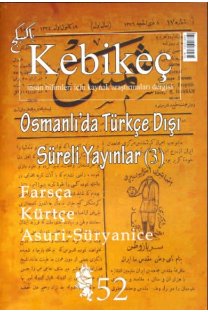Evrim, Genetik ve Irk: Evrimsel Biyolojinin Işığında İnsan Irkının Anlamsızlığı
Temelinde türlerin değişmezliği yatan sömürgeci bir tasnif aracı olarak ırk kavramı biyolojik olarak anlamsızdır. Son 45 yılın protein ve DNA düzeyi çeşitliliğine insan toplumlarında odaklanan genetik çalışmalar, eski fizik antropolojinin ve yerleşik popüler algının yaptı- ğı gibi, insan toplumlarının keskin gruplara ayrılamayacağını göstermektedir. İnsan türünün genetik çeşitlilik miktarının ezici bir kısmı herhangi bir toplum içinde varlığını devam ettirmekte, insan türünü biyolojik açıdan bariz kategorilere ayırmak mümkün olmamaktadır.
Evolution, Genetics and the Race: Evolutionary Biology and the Fallacy of the Human Race Concept
Human race concept, which has its historical frame in colonialism and old fashioned classification, has no biological basis. Work on the human populations in the past 45 years clearly indicates that, contrary to the outmoded categorization of old biological anthropology and the popular conceptualization, human populations have no strict boundaries between them. Greatest part of the human total genetic variation as a species is included within any population. Consequently, it is no valid an assumption that human species can be partitioned into biologically objective and persistent "race" categories.
___
Allison, A. C., "Aspects of polymorphism in man", Cold Spring Harbor Symposia on Quantitative Biology, 20 : 239-255, 1955.Bowler, Peter J., The Eclipse of Darwinism: Anti-Darwinian Evolution Theories in the Decades around 1900, John Hopkins, 1983.
Cavalli-Sforza L. L., Menozzi P., Piazza A., The History and Geography of Human Genes, Princeton, 1994.
Darwin, Charles, On the Origin of Species, Longman, 1872.
Giblett, E. R., Genetic Markers in Human Blood, Oxford and Edinburgh, Blackwell, 1969.
Hubby, J. L., R. C. Lewontin, "A molecular approach to the study of genic heterozygosity in natural populations. I. The number of alleles at different loci in Drosophila pseudoobscura", Genetics 54: 577-594, 1966.
Huxley, Julian, Evolution: The Modern Synthesis, Harper and Brothers, 1943.
Lewontin R. C., J. L. Hubby, "A molecular approach to the study of genic heterozygosity in natural populations. II. Amount of variation and degree of heterozygosity in natural populations of Drosophila pseudoobscura", Genetics 54: 595-609, 1966.
Lewontin R. C., "The apportionment of human diversity", Evolutionary Biology, 6 : 381-397, 1972.
Li J. Z., Absher D. M., Tang H., Southwick A. M.,Casto A. M., Ramachandran S.,Cann
H. M.,Barsh G. S.,Feldman M.,Cavalli-Sforza L. L.,Myers R. M. , a.g.e.
Cavalli-Sforza L. L., Menozzi P., Piazza A., a.g.e.
Li J. Z., Absher D. M., Tang H., Southwick A. M.,Casto A. M., Ramachandran S.,Cann H. M.,Barsh G. S.,Feldman M.,Cavalli-Sforza L.L.,Myers R.M., relationships inferred from genome-wide patterns of variation", Science 319: 1100-1104, 2008. " Worldwide human
Mourant A. E., The Distribution of Human Blood Groups, Oxford, Blackwell, 1954.
Pickering, Charles, The Races of Man: And Their Geographical Distribution, H.G. Bohn, London, 1851.
Ruvolo, M. ve M. Seielstad, " The apportionment of human diversity: 25 years later", Thinking About Evolution: Historical, Philosophical, and Political Perspectives, Editörler: R.S.Singh ve ark., Cambridge University Press, içinde, syf.: 141-151, 2001.
Schrago, C. H., "The effective population sizes of the Anthropoid ancestors of the human- chimpanzee lineage provide Insights on the historical biogeography of the Great Apes", Molecular Biology and Evolution, 31(1): 37-47, 2014.
Sturtevant, Alfred H., A History of Genetics, Harper and Row, 1965.
- ISSN: 1300-2864
- Yayın Aralığı: Yılda 2 Sayı
- Başlangıç: 1995
- Yayıncı: Mehtap Yüksel
Sayıdaki Diğer Makaleler
"Ankara Aslanları" Hakkında Birkaç İlave Husus
Çevresel ve Paleoiklimsel Faktörlerin Etkisinde Doğu Afrika'da İnsanın Evrimi
Evrim, Genetik ve Irk: Evrimsel Biyolojinin Işığında İnsan Irkının Anlamsızlığı
Karadeniz'den "Sol" Esinti Toprak (Samsun/1940-1941)
20. Yüzyılın Başında İstanbul Limanı: Hamallar Dersaadet Rıhtım Şirketi ve Osmanlı Hükümeti
"Hasta Adam" Ülkesindeki Küçük Kuzenimiz
Bir "Kırk Kere Söylersen Gerçek Olur" Vakası Olarak "Dini Islah Beyannamesi" ve "Gerçeğin" Kaynağı
